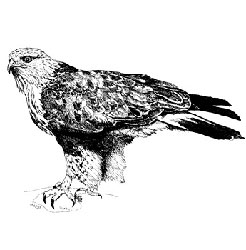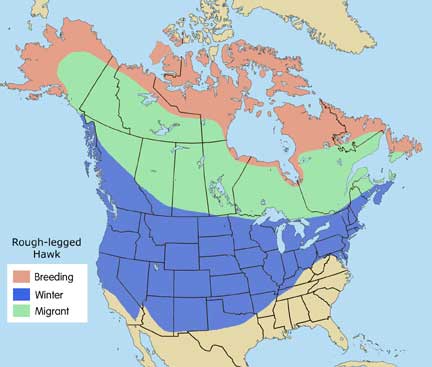
Scientific Name: Buteo lagopus
A large, long-winged, long-tailed hawk; females are larger than males. The Latin name means “rabbit-footed,” as the legs are feathered completely down to the small yellow feet. The pattern and amount of dark is extremely variable in this species. In the common light morph (light-colored variety), this hawk is more boldly patterned compared to other buteos, with brown back and wings, but head, neck, underside and thighs white or buffy with streaks or spots of brown; females and immatures have a dark belly band, while the adult male has a darker “bib” across the breast, and paler belly. The tail is pale with dark bars, dark at the end. When viewed in flight, square black patches at the wrist, or bend, of the wing underside are a distinctive feature. Flight is active with slow, flexible wingbeats; soars in a medium dihedral (v-shaped attitude of wings), and hovers frequently.
Male/Female
Length: 18 – 23″
Wingspan: 48 – 56″
Weight: 1.6 – 3.0 lb.
State and federally protected.
Open country; breeds on Arctic tundra and mixed tundra / boreal forest. Whole population moves south in winter, keeping to open farmland, marshes, other open areas; often migrates in large flocks, arriving in early to mid – autumn; are settled in winter territory across the U.S. from November to March. Often roosts communally in winter, usually in conifers.
Small to medium sized mammals. Hunts in open areas from a low perch or elevated spot; frequently hover hunts. May be found in same area and eat the same food as Red-tailed Hawks, but avoids direct contact and competition with that species by hunting from lower perches, keeping more to open areas, and using a less sedentary hunting style.
Soft, plaintive courting whistle in breeding season; alarm call is a loud screech or squeal, or a drawn-out, descending, whistled kee-eeer.
Very territorial in summer. Builds nests on elevated sites on open tundra, using a wide variety of locations, such as eroded riverbanks, rock outcrops, ledges – any place that provides some protection against predators. Ability of this species to use many different types of nest sites is important in their survival, since they must compete for available sites with resident Ravens and Gyrfalcons, as well as with Peregrine Falcons that arrive in northern breeding grounds at the same time.
For those seen at Cascades Raptor Center is collision with cars/trucks.

Circumpolar (unlike other North American buteo hawks, is not limited to the New World).
Special Thanks for range maps:
Dan Gleason
BGleason Design & Illustration
Commercial & Scientific Illustration, Graphic Design
CraneDance Communications
Book Production/Design

